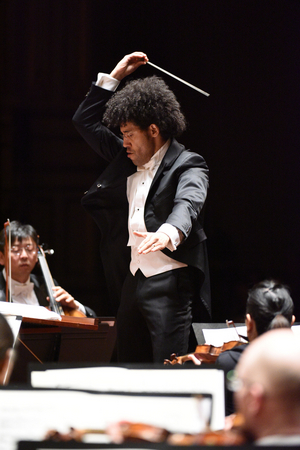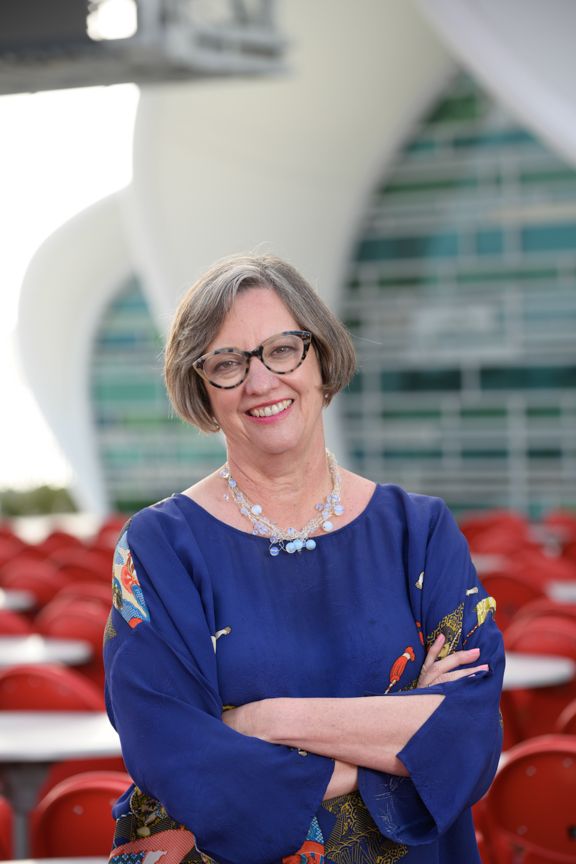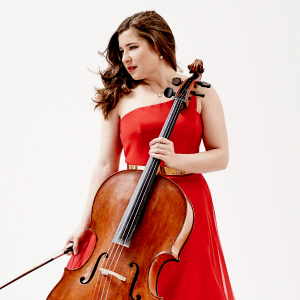Interview: Rafael Payare Music Director and Conductor of THE SAN DIEGO AND MONTREAL SYMPHONY ORCHESTRAS
A Conductor's Exploding Career

The San Diego Symphony's Music Director and Conductor Rafael Payare took up the notoriously difficult French horn at the age of 13. During an hour-long Zoom interview while he was in Montreal, I asked how he had managed to become a soloist less than six months later! "I have to admit it was a little bit fast," he said. Not the haughty egotistical answer I might have gotten from film conductor-stereotypes. His local youth orchestra, a part of Venezuela's extensive El Sistema program, needed horns, so he joined a few weeks after first picking one up. "For a couple of classes, I could only play one scale, but somehow something clicked, and I just started playing more." Less than half a year later he passed an audition for the national youth orchestra, and later became Principal Horn with the prestigious Simón Bolívar Youth Orchestra, the one that first brought Gustavo Dudamel to the attention of the conducting world.
El Systema's founder José Antonio Abreu was the first conducting coach of both Dudamel and Payare and a huge influence on their lives and beliefs. Abreu showed them music is a force for social change. While I'd already known they believed that, I hadn't realized it was a major reason Payare was offered and accepted his position in San Diego. "When I spoke with (CEO) Martha Gilmer, I became excited because her fantastic ambition aligned with what I wanted to

do. Wherever I go I try to lift the orchestra to a higher artistic plateau and to bring live music to as many people as possible. I am wired this way."
A relatively late starter, Payare was 31 when he took first prize at the respected Malko Competition for Young Conductors. He said he'd had no thought of winning, only hoping to pass the first round because that meant the Competition would cover his expenses in Copenhagen. But he did win and became head of the Ulster Symphony in Belfast just two years later. There he quickly showed he'd taken Abreu's belief in social change through music to heart, staging some rehearsals near a street dividing Protestant and Catholic areas. "We'd have open rehearsals so people from either community could come in for the pleasure of listening to music without caring so much about religious differences."
He has similar thoughts for San Diego. "We want to explore the possibility of having something like El Sistema. I know the city has many youth orchestras. So does nearby Tijuana." He's thinking of beginning projects with individual schools here and across the border to form what El Sistema calls a "nucleus" for concerts that would combine students from both countries. "So we could have an orchestra that will give that sense of community."
Even before the Rady Shell opened, Payare envisioned student concerts there, sometimes in conjunction with symphony musicians. "Why not have an orchestra of 500 playing in the Shell, you know, why not? We need to dream big. Some of those students may become musicians if we give them that experience." It would show them it was a real possibility, one Payare himself realized when he had similar experiences in his youth that led to a life he loves.
"The beautiful thing about conducting is that you never stop learning. You want to be faithful to the score, but there's so much more behind it. I try to find out why a composer wrote a piece and what they wanted to express. The more information you have the better. That doesn't mean you have to put everything into a performance. If you're thinking too much you're going to get something too heavy." He compares it to deciding which ingredients you want to use and how much of each when cooking. (Cooking similes come easily to him. He loves the different foods his travels introduce him to.)
Even fundamentals such as tempo and dynamics can be difficult to decide. How fast is fast, how loud is loud. Mahler's scores help more than most. "The fifth symphony has a 25-page introduction for the conductor. He writes notes like, 'These episodes you have to make a little bit faster, don't let the orchestra to go slower; do not push it here; make sure to rehearse these episodes, this passage in the woodwind section isn't easy to play.'" And because hall sizes and instruments have changed over time, a composer may have written for a smaller space or instruments that were louder or softer. "You take it all in to try and understand the seasonings that make the right flavor."
Ulster's offer of their Chief Conductor position surprised him. He thought it a joke when they asked if he wanted the job during dinner the day he was there as a guest conductor. Two days later he received a formal offer. While there for five years, he also guest conducted at many of the world's most admired orchestras including the Vienna Philharmonic and the London, Boston and Chicago symphonies. He remains an Ulster Conductor Laureate, but has committed to seven seasons in San Diego and more recently, five on the other side of the continent in Montreal. "With two orchestras, I have to cut back on guest appearances." Pile on increasing recognition as a talented opera conductor and scheduling is an even greater issue because of the length of opera rehearsal-times.
"I was in Copenhagen rehearsing Tosca all of March. We premiered April 2nd, then I came back to this side of the pond for a concert with the Montreal Symphony before returning to Copenhagen for three more performances of Tosca. It's kind of complicated, but I try to have at least one title per season."
(The San Diego Opera's orchestra is made up of San Diego Symphony musicians and he conducted the company's 2020 production of La bohème. I speculate the "one title" may sometimes be a San Diego performance.)
His multiple orchestral responsibilities offer unusual opportunities. "Every orchestra is like a living organism with its own repertoire, tradition, sound, and relationship to the community. It's wonderful to have amazing orchestras in two border cities with different environments, languages and histories." Even if they do the same piece, it won't sound quite the same. Vibratos and even intonation are different. Montreal uses a standard A of 442, while the U.S. is at 440. Many believe the higher tuning makes for a more "brilliant" sound. Perhaps related, "Montreal has an amazing transparency in the woodwinds which works well in French and Russian repertoire."
The Canadian orchestra has a longer history of well-known chief conductors and a far more extensive recording catalog. Payare believes that San Diego's excellence is underappreciated, but the number of young musicians vying for open spots indicates that's changing. "We auditioned around 98 for our most recent violin opening."
Plans to show how far the orchestra has come include "crazy beautiful projects, sometimes teaming with Montreal. Each orchestra can learn from how the other goes into the community, and our first shared commission is a work by Austrian composer Thomas Larcher."

Payare's excitement about San Diego is due partly to the new Rady Shell on the waterfront and substantial upgrades underway at Symphony Hall in the Jacobs Music Center. Both will offer state-of-the-art sound. Changes in the Hall will eliminate huge acoustical differences that depend on where you sit. Equally important, an improvement in how well the musicians on stage can hear each other will make it easier for conductors to get the sound they are after. Payare raves about the difference the Rady's Meyer sound-system has made for both musicians and audiences.
"I mean, Gustavo (Dudamel) came to the opening of the Shell and really loved it. He was like, wow!" That's a common, though usually less expert opinion.
Recordings too will have a role in the Symphony's plans for greater visibility. The first is on Platoon with Payare conducting a live performance of Shostakovich's 11th Symphony, subtitled The Year 1905. I didn't quite know what it meant when early in his career he said he hoped to suffer and delight with an ever-expanding repertoire. I now realize he meant he lives what music has to say. In the rehearsals before the performance of the symphony, "We were discussing the structure and how graphic the piece was. We could hear the woods and smell the blood. The whole orchestra was as if in a trance." They were living the music so intensely, they had to defer a second rehearsal to the following day. In concert, "It was a massive sound, really really loud. After the chime at the end the audience sat silent for a long time then jumped up in an explosion of applause. It was wonderful. That symphony is the kind of thing you suffer but enjoy."

As Payare's career has flourished, so has that of his wife cellist Alisa Weilerstein. They were married in 2013. Their oldest of two girls is six and the youngest just three months old. The couple is still working out how to manage parenthood with already daunting travel, and now, Payare's new position in Montreal. "They're still at a portable age, but it's going to get a little bit more complicated with school and things like that. We'll have to find the right balance."
Although Payare says music has driven everything he's done in life, the far from stern conductor retains a boyish love of baseball, and the San Diego Padres are on his viewing list. "I am very excited. I really love baseball and couldn't follow Venezuelan baseball while living in Europe because of the time difference. So going to a Padres game last season brought me back to fandom. The ballpark is beautiful, a wonderful place to be. I love it."
There is room for baseball, but he'd like to perform the complete symphonies of Bruckner, Wagner's Ring Cycle, Mozart's 41 symphonies and much more. For "suffering and delight," not even a grand slam can compete with a performance that brings an audience to its feet with a combination of bravos and tears.
The San Diego Symphony's concert schedule is available here, the Orchestre symphonique de Montréal schedule is available here.
Photos compliments of San Diego Symphony
Comments

Videos

